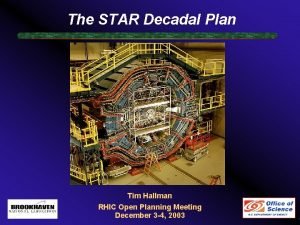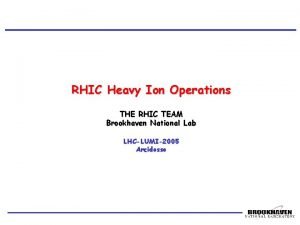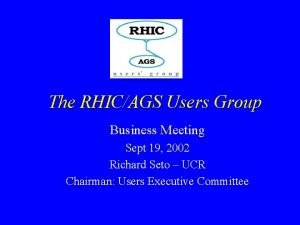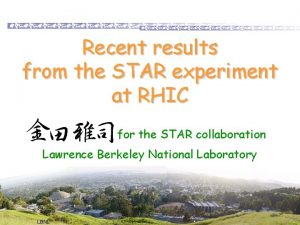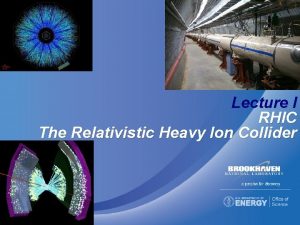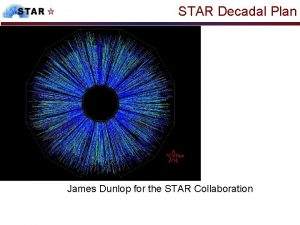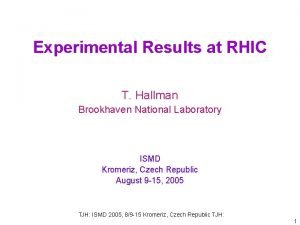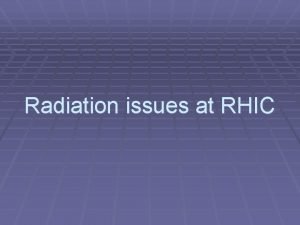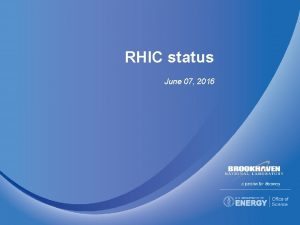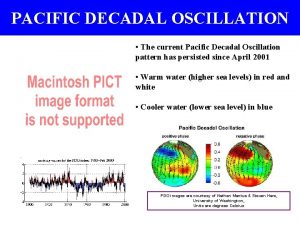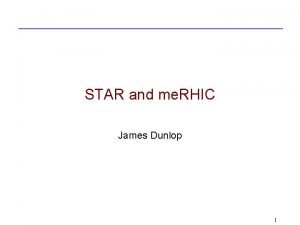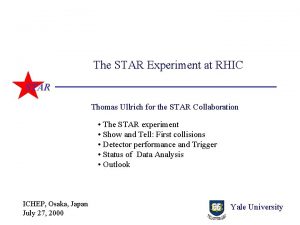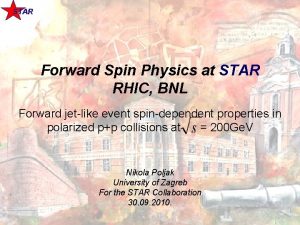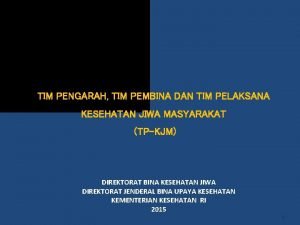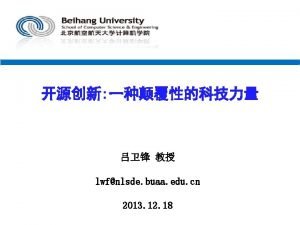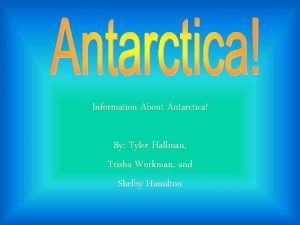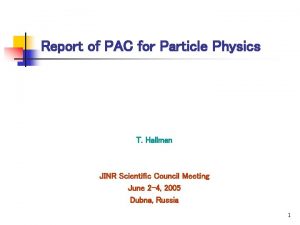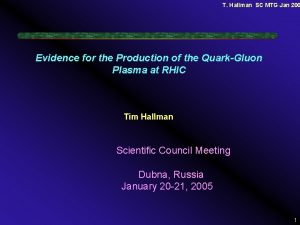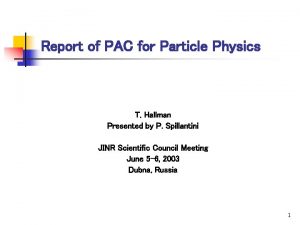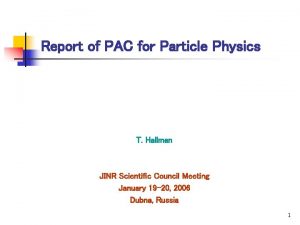The STAR Decadal Plan Tim Hallman RHIC Open



































- Slides: 35

The STAR Decadal Plan Tim Hallman RHIC Open Planning Meeting December 3 -4, 2003 1

The STAR Decadal Plan This talk: • addresses the period now to 2010 + • Provides a vision of the compelling science STAR proposes to accomplish (a picture being developed) - high Q 2 (triggered) probes - studies of bulk phenomena high luminosity, good tracking, and vertexing fast DAQ, FEE • Identifies important R&D and upgrade directions that are beginning now to carry out the proposed program 2

Three “Must do” STAR Physics Goals in the next 5+ years that drive the planned use of RHIC: – Have we produced the quark-gluon plasma • p. T dependence of suppression • Measurement of open charm and charmonium • Full flow systematics (mesons, baryons, multiply strange baryons, open charm) • Evolution versus energy/species – Gluon contribution to the nucleon spin • ALL for mid-rapidity jet production • ALL for direct photon + jet – Gluon density saturation in cold nuclei at very low Bjorken x • Inclusive leading hadrons/jets in d+Au collisions • Search for mono-jets in d+Au collisions With a 27 week standalone run each year only one of these can be accomplished 3

A Strategic Approach / Scientific Plan for STAR Significant results from 1 shift at s. NN = 19. 6 Ge Why does it work: large acceptance and very high tracking/detector e STAR Preliminary NA 49 STAR The results from one shift of data taken at s. NN = 19. 6 Ge. V ! 4

A Strategic Approach/ Scientific Plan for STAR First high pt suppression data at s. NN = 130 Ge. V from a relatively short ( 2 week) period of actual data taking pointed out the need for more data at 200 Ge. V, and finally the need for d+Au leading to: Au+Au, s. NN = 130 Ge. V A diverse portfolio of soft physics studies and measurements of rare probes is possible within STAR Pedestal&flow subtracted 5

STAR Rare Probes Di-Jet trigger in d+Au collision in STAR EMC 6

Opening a Window in STAR on Onium First look in STAR at the onium states (J/ , Upsilon, and excited states) to measure thermodynamics of deconfinement through varying dissociation temperatures To deeply probe the plasma through studies of (Debye) screening length l ~ RHIC Study vs. p. T Study vs. centrality Study in lighter systems Study vs a control (the ) l Upsilon rate ~ 10 -3 J/Y Yield in 10 weeks of Au. Au running at 32 μb-1 /week will be a start To fully utilize this probe requires 7

STAR Scientific Approach STAR has tremendous capability and flexibility due to its large accep and efficient, complimentary suite of detectors A robust program of measuring rare probes, as well as soft physics observables to study the bulk matter properties is possible STAR believes the way to achieve maximum scientific impact and fu utilization of the machine is to have a balanced portfolio: soft physics studies of the properties of the bulk matter triggered rare probes measurements change of energy change of system size This will provide the most leverage in understanding the new matter produced at RHIC. 8

For the physics that drives the Run IV BUR, the requirements are: Goal Hours/week 30 M (50 M) Central s. NN Dead Time Weeks Min L 0 200 50% 6(10) 12 μb-1 /week 50 M Min-Bias 45 200 50% 6. 8 2 μb-1 /week Even for rare probes relatively modest running π to p. T 15 Ge. V/c 45 200 50% periods yield 6 (10)significant 33 reach in pt ( 8 Ge. V/c at s. NN = 63, which is the full reach of the reference) -1 (20) μb /week 4σ signal 45 200 50% 10 32 μb-1 /week This isp. T reflected to 63 request 100% for 5 year, 271 week projection h± to 8 Ge. V/cin response 45 1. 8 μb-1 Run/Weeks Mode 1/Weeks Mode/week 2/Weeks Mode 3/weeks Mode 4/weeks Run IV, 27 Run VI, 27 Run VIII, 27 45 Au. Au @ 200, 5+14 p+p @ 200, 5 Au. Au @ 20, 2 Au. Au @ 40, 3 d+Au @ 200, 5+9 p+p@200, 5+5 Au. Au@200, 5+5 p+p@200, 5+9 Au. Au@200, 5+10 p+p@500, 5+5 Au. Au @ 63, 5 + 4 p+p @ 200, 5+5 But… STAR’s conclusion is that scenario is unworkable achieve the goals of both the heavy ion and spin physics pr 9

Future STAR Spin Physics Goals – G (x) determination via ALL in p+ p + jet + X – u , d determination via ALPV in p + p W ± + X @ s = 500 Ge. V To get into the game: Ø s = 200 Ge. V, P 4 L eff dt 100 pb – 1 Ø s = 500 Ge. V, P 4 L eff dt 250 pb – 1 10

The Nature of the Problem Spin Physics Machine Development that has to happen: Test effectiveness of NEG coated beam pipe Commissioning of polarized gas jet target Commissioning of warm-bore helical dipole 5 +0 weeks in Run IV? Commissioning of RHIC AC dipole Establish new RHIC working point (WP) (2 IR’s ? ) Luminosity in Roser model somewhat better than Run III (~ 1 pb-1/week) at thi Testing of RHIC working point First calibration of gas-jet target Luminosity development Run V Commission cold bore helical dipole (P 70%) 5+5? Complete calibration of gas-jet target Luminosity in Roser model something like 2 pb-1/week at this point Annual access for key developments is inconsistent with long runs to luminosity and polarization required ( > 10 pb -1/week, 60 -70% ): A 27 week standalone run will not work for both the heavy ion and spin 11

Some important strategic considerations for STAR: There is excellent, high impact science waiting to be done, near and long term ! p+p π°+ x Possible for Run IV A number of Institutions have or will invest in junior faculty appointments in the area of RHIC Spin: SUNY Stony Brook Indiana University Massachusetts Institute of Technology U. C. Riverside University of Illinois The period 2005 -2006 is a natural time frame to try to achieve several of the main spin physics Goals: Analysis of the large data set from Run IV will take a significant amount of time After this period, new upgrades for the ion program will start to come on the The evolution in this area has consequences for the future of both the heavy ion and 12 horizon

A Possible Path Forward: Within STAR, in the context of the planning group discussions, alternative scenarios have been discussed, including the constant effort scenario (#2) shown by Tom Ludlam. With 5 weeks of additional running there is a qualitative change in the robustness of the program. This allows: an energy scan a species change high statistics Au+Au running a second d+Au run robust, timely spin physics (ΔG(x) and commissioning for Ws at s = 500) In preliminary discussions STAR’s preferred 32 week scenario: Run/Weeks Run IV, Run VI, Run VII, 32 32 Mode 1/Weeks Au. Au @ 200, 5+14 Au. Au @ 63, ? , 6+8 Cu+Cu @ 200, 5+8 Au. Au@200, 5+10 Mode 2/Weeks p+p @ 200, 5+0 p+p @ 200, 5+10 p+p@200, 5+11 d+Au@200, 5+9 13

RHIC II Physics in STAR QCD studies of unprecedented breadth and depth • Detailed studies of the fundamental properties of matter by heating the QCD vacuum • Studying the accompanying phase transitions, and the hot, superdense states preceding the formation of a plasma of quarks and gluons to understand e. g. : – the nature of chiral symmetry breaking and how is it related to masses of the hadrons the – the quark mass dependence of partonic energy loss – collective behavior in partonic systems – the nature of a possible saturated gluon state in cold nuclei at low Bjorken x 14

RHIC II STAR Physics Probes: In the heavy ion program, to test and extend QCD theory and its predictions regarding the behavior of bulk color-deconfined matter, STAR will: – use hard probes such as • • • Inclusive jets and direct photons back to back jets (correlation of leading particles) direct gamma + leading hadron from jet flavor tagged jets measurement of spectra and yields for the Upsilon family of states to measure the differential energy loss for gluon, light quark, and heavy quark probes which couple differently to the medium – measure very large samples of “soft physics” events to unfold the bulk properties of the produced matter, studying e. g. • • heavy quark thermalization heavy baryon / meson (open charm) elliptic flow spectrum of extended hadronic matter (resonances) broken / restored symmetries (e. g. , cp violation, chiral restoration) 15

High Luminosity STAR Physics d. N/dyd 2 p. T (y=0) (Ge. V-2 c-3) Quantitative measurements of partonic energy loss Measurement of the gluon density via High p. T hadrons in coincidence with direct + jet and flavor-tagged jets to study the quark mass dependence of 1/2 Au. Au (b = 0), s = 200 Ge. V energy loss • Leading hadrons are very rare: only ~0. 1% of jets fragment hard enough that hadrons are above incoherent background • cross section for + jet coincidences (central Au+Au): • E =10 Ge. V: 6 nb/Ge. V • E =15 Ge. V: 0. 6 nb/Ge. V • 50 weeks of Au+Au @ RHIC I design: 10 nb-1 !! luminosity upgrade needed to access this physics! PT (Ge. V/ c) 16

STAR Future Physics and Planned Upgrades The next step? -- Trying to be quantitative and understand quark mass dependence of partonic (? ) energy loss. A possible approach: differential energy loss of gluon, light quark, and heavy quark jets • • • Statistical, kinematic separation of gluon and light quark jets based on underlying PDF’s and “reconstructed” parton- parton cms flavor tagging of heavy quark jets Dokshitzer and Kharzeev D/ , B / ratio versus p. T (hep-ph/0106202): 0. 8 d. V 1 qsea 1. 4 u. V Q 2 = 100 Ge. V 2 10 g(x) Q 2 = 10 Ge. V 2 10 -3 10 -1 XBJ 10 -3 10 -1 Suppression of co-linear gluon radiation Further theoretical and experimental development needed ! 17

Pressing the search with heavy flavor: first direct observation at RHIC of open charm in d+Au and min-bias Au+Au Open charm: a probe of initial conditions, and possible equilibration collisions at early times D 0 K , d+Au Star Preliminary |y| < 1, pt < 4 Ge. V/c D± K , d+Au STAR Preliminary | y |< 0. 25, 7 <pt <10 Ge. V/c For high statistics measurements and event-by-event open charm, MRPC TOF an silicon μvtx essential (This buys a factor o ~ 100 reduction in event sample require Do c quarks thermalize? If yes, ratio of charm D± K , Au+Au hadrons yield changes from p-p to Au-Au ; Ds+ most sensitive. Pythia Au-Au A. Andronic, p-p 200 Ge. V Thermal* P. Braun. D+/ D 0 0. 33 0. 455 Munzinger, K. Redlich, Ds+/ D 0 0. 20 0. 393 J. Stachel c+/ D 0 0. 14 0. 173 STAR Preliminary (nucl-th/0209035) J/Y/D 0 0. 0003 0. 013 18

STAR Future Physics and Planned Upgrades With regard to flavor tagging, e. g. Ramona Vogt, hep-ph/0111271 p+p Ø p. T ~ 15 Ge. V/c: (p+p)~5 x 10 -4 b/Gev (Au+Au) ~ 20 b/Gev Ø centrally produced 5 years of Au+Au =10 nb-1 200 K b-bar pairs The yield is there! Can they be pulled out? 19

STAR Future Physics and Planned Upgrades A First look - Using a proposed STAR VTX Detector B - Jet Tagging - Heavy Quark Energy Loss: B e+/- + hadron + X EMC triggers e+/- from B, • Vertex cleans the sample - Pe > 4 Ge. V/c, Ph > 0. 7 Ge. V/c - DCA between e and h < 150 m • - Assume 50% e+/- misidentification High pt e+/- triggered by EMC – Enhance yield; some h +/- mis-id’d as e+/– Remove hadronic background Associate e+/- with h +/- at a displaced vtx – DCA sign positive if displaced vertex and Pe point in the same direction CDF Data STAR vtx simulation distance The first look is encouraging! 20

, , *(892), *(1385), *(1520) , D* STAR Future Physics and Planned Upgrades Probing Rescattering: Resonances pp Au+Au 40% to 80% 0 f 0 K 0 S K*0 • STAR Preliminary 0. 2 p. T 0. 9 Ge. V/c |y| 0. 5 Short-lived resonances probe the medium and map the history wrt rescattering after chemical freezeout pp STAR Preliminary 0. 2 p. T 0. 8 Ge. V/c Large data samples necessary PID from TOF essential to extend p. T reach STAR preliminary p+p at 200 Ge. V |y| 0. 5 K*0 K*/K pp – Destruction of signal in hadronic channel – Regeneration in “elastic” scattering stage • • *(1520) Statistical error only Au Au 21

To carry out its future program STAR needs: • A Barrel MRPC TOF PID information for > 95% of kaons and protons in the STAR acceptance; extended scientific reach for key observables • A micro-vertex detector precise (3 m) hit position close to the primary vtx D’s , flavor- tagged jets • A DAQ/ TPC FEE Upgrade new architecture / FEE 1 khz of events sampled at L 3; effective integration of 10 x more data • Development of GEM tech. Preparation for a compact, fast, next generation TPC needed for 40 x L • Forward Tracking Upgrade W charge sign identification • High Luminosity 10 - 50 times the luminosity (10 nb-1) integrated at RHIC up to 2010 (Thomas Roser will provide) 22

STAR Future Physics and Planned Upgrades The STAR MRPC TOF Barrel will: Ø allow STAR to provide PID for an additional 60% of the particle in the hadronic final state Ø Cut the time (events) needed to measure the open charm yield by a factor of 5 (12. 6 M 2. 6 M) (TPC + SVT versus TPC + SVT + TOF) Ø Cut the time (events) needed for bulk measures (e. g. heavy baryon elliptic flow) which may distinguish between hadronic/ partonic degrees of freedom by a factor of 10 (200 M 20 M) Ø allow the detailed unfolding of large and small scale correlations & fluctuations to map the dynamics/evolution of the produced matter Ø extend the pt reach to for measuring resonances to 1 -2 Ge. V/c affording a precision tool for model comparison and a definitive determination of the importance of re-scattering versus regeneration (calibration of an important set of standard candles) 23

The STAR Barrel TOF MRPC Prototype Tray Construction at Rice University MRPC design developed at CERN, built in China FEE 28 MRPC Detector s; 24 made at USTC Neighbor CTB Tray 70 ps, 2 meter path Strong team including 6 Chinese Institutions in place EMC Rails Completed Prototype 28 module MRPC TOF Tray installed in STAR Oct. ‘ 02 in place of existing central trigger barrel tray 24

The STAR Barrel TOF MRPC Prototype modules met all performance specs in the STAR environment and produced important physics on PID’d Cronin Effect Proposal reviewed and approved by STAR and submitted to BNL Management 25

Important new data from the MPRC TOF Prototype Results will be key to help understand the processes underlying particle production in the intermediate p. T region Entirely new capability for measuring open charm opened up as well ! 26

STAR Future Physics and Planned Upgrades Physics provided by the STAR Vertex detector • Open charm – Charm quark yield • Reconstructing D 0 – Charm hadron chemistry • Reconstructing D+, Ds+, … – Charm hadron flow • Constructing D 0 spectra • Open beauty – Identifying B mesons • Identifying heavy quark jets Thin silicon ladders under tension 27

STAR Future Physics and Planned Upgrades Key features of the proposed STAR vtx detector: Ø ultra-thin 50 m silicon (APS) chips Ø excellent position resolution (~5 m), 20 m x 20 m pixels Ø minimal coulomb scattering, beam pipe wall < 600 m Ø state of the art mechanical support allowing easy insertion/removal and eventual replacement with faster APS chips Ø 10 -20 ms readout initially; storage of all events in 20 ms “bucket”; per pixel probability of hit 0. 5% at 4 x L; per pixel probability of pile up in 20 ms, ~ 10 -5 Ø data matching offline Ø upgrade to 5 ms readout for 40 x luminosity upgrade 28

STAR Future Physics and Planned Upgrades The DAQ and Front End Electronics Upgrades • The DAQ and FEE upgrades will allow STAR to acquire large data samples, increasing the luminosity effectively integrated by STAR by a factor of 10 • This upgrade will increase the number of events sampled to 1000/sec minimum bias, ~ 200 Hz central. The baseline plan is to present these to level III and write out 100/sec. • The upgrade will address the present bottlenecks throughout the DAQ/FEE chain: DAQ CPU VME Bandwidth Event Builder LIII CPU FEE Chip Speed Analog Processing Zero Suppression Noise 29

STAR Future Physics and Planned Upgrades The Scope & Scientific Merit of Proposed R&D / Upgrade Plan System R&D Constr/Cost Benefit to STAR Barrel MRPC TOF ‘ 04 ‘ 05 $260 k ‘ 05 ‘ 06 $4. 3 M + $2. 5 M in- kind Inner vtx (Forward Tracker) ‘ 04 ‘ 06 $ 965 K ‘ 06 ‘ 07 $4 M (TBD) D’s , flavor- tagged jets (Charge sign for W± ) DAQ Upgrade ‘ 04 ‘ 06 $1. 77 M ‘ 06 ‘ 08 $5 M 1 kz L 3; D’s; & D, v 2, cp, D thermalization FEE Upgrade ‘ 04 ‘ 05 $250 k ‘ 05 ‘ 06 $2. 5 M 1 kz L 3; D’s; , D, v 2, cp, D thermalization ‘ 04 ‘ 06 $900 k ‘ 08 - ‘ 10 ? GEM De. V Serious R&D on these projects has begun PID information for ~ 95% of kaons and protons in acc; extended p. T for resonances; v 2; D’s; ebe correlations; anti-nuclei; inclusive electrons Compact, fast TPC; robust tracking for high Q 2 physics at 40 x L 30

STAR Future Physics and Planned Upgrades This projection for the TPC assumes the following RHIC Luminosity Upgrade Plan Enhancements possible with existing machine: Double the number of bunches to 112 Decrease b* from 2 m to 1 m 4 x increase in ave. L; Still limited by Electron beam cooling at full RHIC energy will eliminate intra-beam I. B. S. scattering effects and reduce beam emittance: 10 x increase in average luminosity Evolution of Au Au parameters: Luminosity in units of 1026 cm-2 sec-1 Current in units of 1010 ions/beam 31

STAR Future Physics and Planned Upgrades The GEM Development: essential for STAR tracking in the High Luminosity Era at RHIC In 2010: • the STAR TPC will be ~ 15 years old • large space charge distortions and pile-up may be problematic for the high luminosity, high pt program STAR intends to carry out The proposed GEM development will: • lay the foundation for a possible future high rate, compact TPC with shorter drift and additional trigger capability • develop important technology which may also be needed elsewhere in STAR (e. g. forward tracking) 32

STAR Future Physics and Planned Upgrades What about the STAR Spin Program u , d determination via ALPV in p + p W ± + X @ s = 500 Ge. V G (x) from) pp + X The baseline physics will take until ~ 2010 A forward (GEM ? ) tracking detector will be needed for W+/- sign 33

STAR Decadal Plan Conclusions STAR proposes a future program of QCD studies of unprecedented breadth and depth to study – the nature of chiral symmetry breaking and how is it related to the masses of the hadrons – the quark mass dependence of partonic energy loss – collective behavior in partonic systems – the nature of a possible saturated gluon state in cold nuclei at low Bjorken x – the helicity preference of gluons inside a proton; the origin of the proton sea; This physics program requires: the transversity distribution for quarks in a proton a Barrel MRPC TOF detector to extend STAR’s scientific reach a micro vertex detector to enable measurement of D’s and flavor-tagged jets a DAQ / FEE upgrade to allow 1 khz to L 3 to integrate needed event samples a tracking upgrade to afford good forward charge sign determination Development of GEM technology to insure the possibility of robust tracking fo the 40 x L era STAR has embarked on this plan; work is 34

The Feasibility of the Future STAR program 21 scientific papers published (16 PRL, 4 PRC, 1 PLB), and 9 submitted (8 PRL, 1 PRC) 18 technical papers published 1060 Citations 28 Ph. D’s granted STAR is a vibrant, strong collaboration which can successfully carry out the proposed program 35
 Tim hallman
Tim hallman Oscilación decadal del pacífico
Oscilación decadal del pacífico Rhic brookhaven
Rhic brookhaven Rhic ags users meeting 2020
Rhic ags users meeting 2020 Rhic
Rhic Rhic
Rhic Myrrh is mine its bitter perfume
Myrrh is mine its bitter perfume Open innovation open science open to the world
Open innovation open science open to the world Ao* algorithm
Ao* algorithm What does star in star events stand for
What does star in star events stand for Hình ảnh bộ gõ cơ thể búng tay
Hình ảnh bộ gõ cơ thể búng tay Ng-html
Ng-html Bổ thể
Bổ thể Tỉ lệ cơ thể trẻ em
Tỉ lệ cơ thể trẻ em Chó sói
Chó sói Chụp phim tư thế worms-breton
Chụp phim tư thế worms-breton Chúa yêu trần thế
Chúa yêu trần thế Các môn thể thao bắt đầu bằng tiếng nhảy
Các môn thể thao bắt đầu bằng tiếng nhảy Thế nào là hệ số cao nhất
Thế nào là hệ số cao nhất Các châu lục và đại dương trên thế giới
Các châu lục và đại dương trên thế giới Công thức tiính động năng
Công thức tiính động năng Trời xanh đây là của chúng ta thể thơ
Trời xanh đây là của chúng ta thể thơ Mật thư anh em như thể tay chân
Mật thư anh em như thể tay chân 101012 bằng
101012 bằng Phản ứng thế ankan
Phản ứng thế ankan Các châu lục và đại dương trên thế giới
Các châu lục và đại dương trên thế giới Thể thơ truyền thống
Thể thơ truyền thống Quá trình desamine hóa có thể tạo ra
Quá trình desamine hóa có thể tạo ra Một số thể thơ truyền thống
Một số thể thơ truyền thống Cái miệng nó xinh thế
Cái miệng nó xinh thế Vẽ hình chiếu vuông góc của vật thể sau
Vẽ hình chiếu vuông góc của vật thể sau Thế nào là sự mỏi cơ
Thế nào là sự mỏi cơ đặc điểm cơ thể của người tối cổ
đặc điểm cơ thể của người tối cổ Giọng cùng tên là
Giọng cùng tên là Vẽ hình chiếu đứng bằng cạnh của vật thể
Vẽ hình chiếu đứng bằng cạnh của vật thể Fecboak
Fecboak
